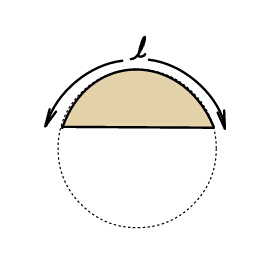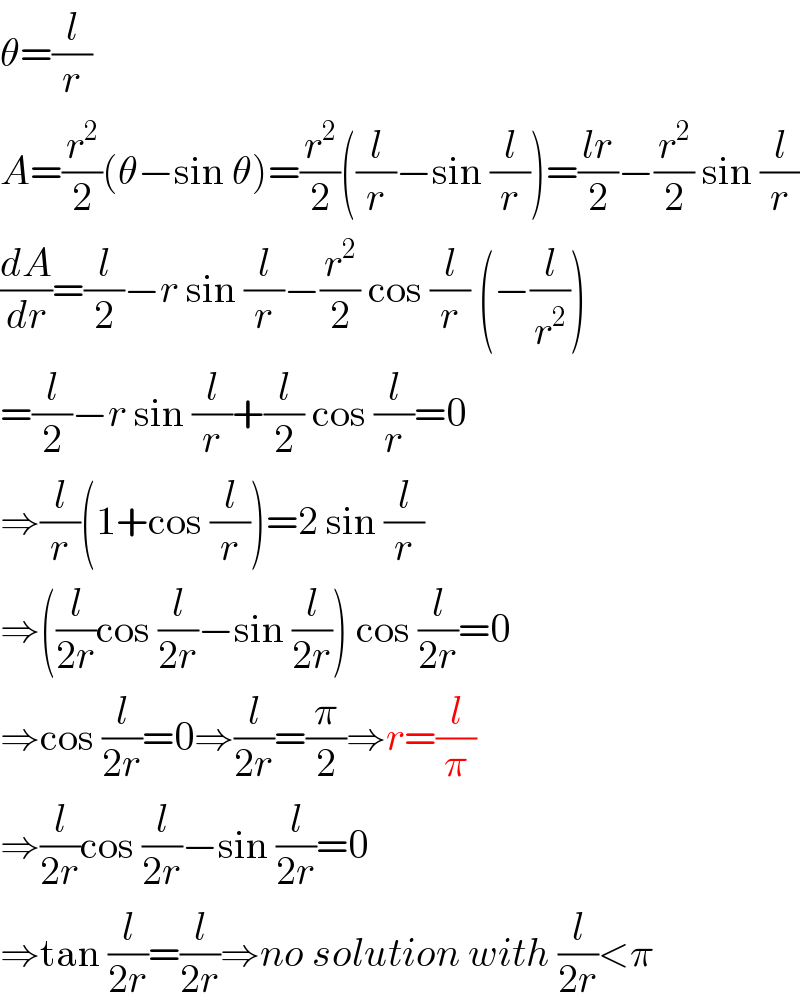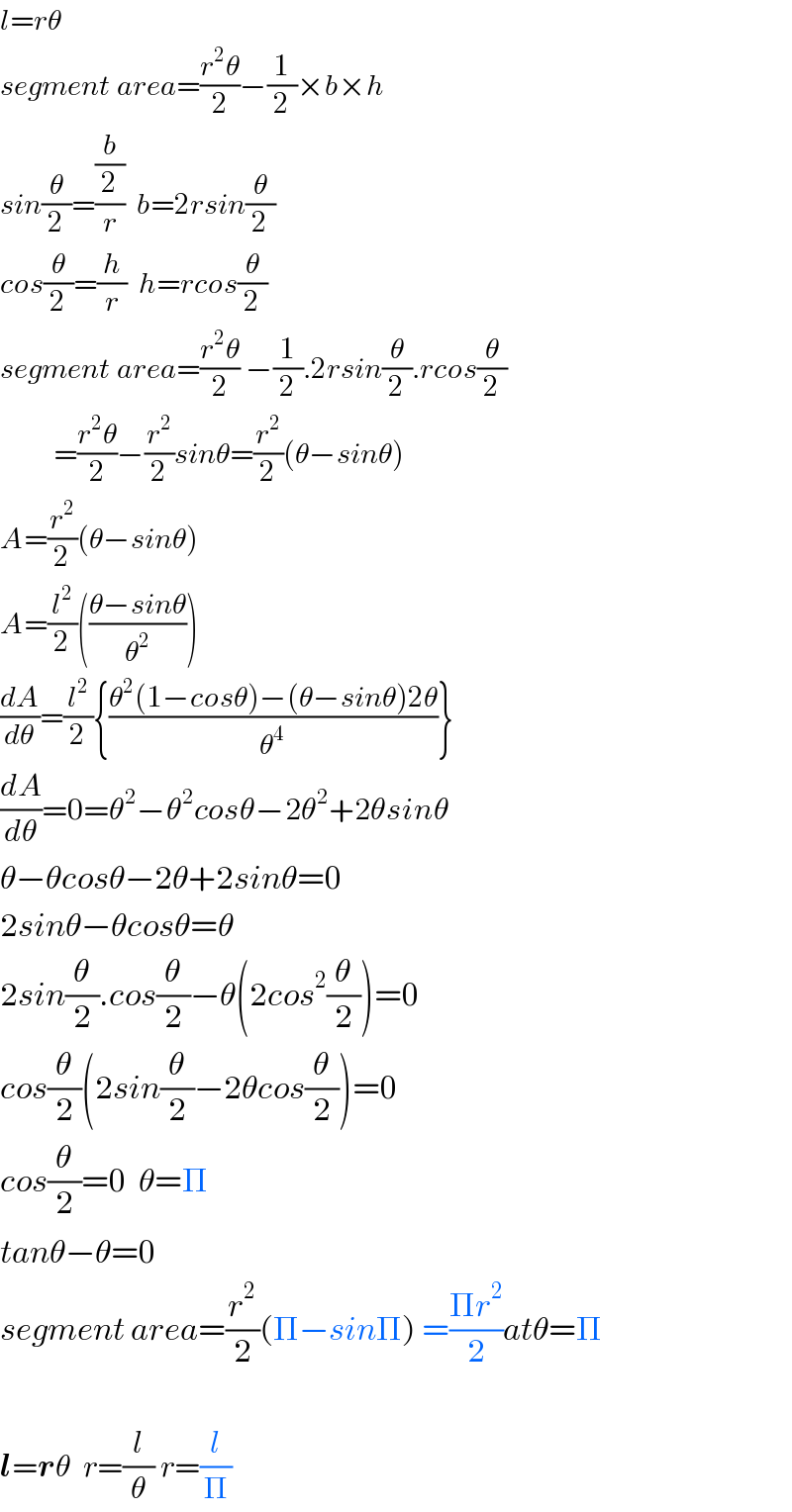Question Number 41157 by ajfour last updated on 02/Aug/18

Commented by ajfour last updated on 02/Aug/18

$${If}\:{arc}\:{length}\:{is}\:{constant},\:{equal} \\ $$$${to}\:\boldsymbol{{l}},\:{and}\:{segment}\:{area}\:{a}\:{maximum}, \\ $$$${find}\:{the}\:{radius}. \\ $$
Commented by MJS last updated on 02/Aug/18

$$\mathrm{I}\:\mathrm{came}\:\mathrm{to}\:\mathrm{the}\:\mathrm{conclusion}\:\mathrm{that} \\ $$$${r}=\frac{{l}}{\pi}\:\Rightarrow\:\mathrm{area}=\frac{{l}^{\mathrm{2}} }{\mathrm{2}\pi} \\ $$$$\mathrm{didn}'\mathrm{t}\:\mathrm{calculate}\:\mathrm{it}\:\mathrm{but}\:\mathrm{it}\:\mathrm{seems}\:\mathrm{obvious}\:\mathrm{to}\:\mathrm{me} \\ $$
Commented by ajfour last updated on 03/Aug/18

$${yes}\:{sir},\:{semicircle}. \\ $$
Answered by MrW3 last updated on 02/Aug/18

$$\theta=\frac{{l}}{{r}} \\ $$$${A}=\frac{{r}^{\mathrm{2}} }{\mathrm{2}}\left(\theta−\mathrm{sin}\:\theta\right)=\frac{{r}^{\mathrm{2}} }{\mathrm{2}}\left(\frac{{l}}{{r}}−\mathrm{sin}\:\frac{{l}}{{r}}\right)=\frac{{lr}}{\mathrm{2}}−\frac{{r}^{\mathrm{2}} }{\mathrm{2}}\:\mathrm{sin}\:\frac{{l}}{{r}} \\ $$$$\frac{{dA}}{{dr}}=\frac{{l}}{\mathrm{2}}−{r}\:\mathrm{sin}\:\frac{{l}}{{r}}−\frac{{r}^{\mathrm{2}} }{\mathrm{2}}\:\mathrm{cos}\:\frac{{l}}{{r}}\:\left(−\frac{{l}}{{r}^{\mathrm{2}} }\right) \\ $$$$=\frac{{l}}{\mathrm{2}}−{r}\:\mathrm{sin}\:\frac{{l}}{{r}}+\frac{{l}}{\mathrm{2}}\:\mathrm{cos}\:\frac{{l}}{{r}}=\mathrm{0} \\ $$$$\Rightarrow\frac{{l}}{{r}}\left(\mathrm{1}+\mathrm{cos}\:\frac{{l}}{{r}}\right)=\mathrm{2}\:\mathrm{sin}\:\frac{{l}}{{r}} \\ $$$$\Rightarrow\left(\frac{{l}}{\mathrm{2}{r}}\mathrm{cos}\:\frac{{l}}{\mathrm{2}{r}}−\mathrm{sin}\:\frac{{l}}{\mathrm{2}{r}}\right)\:\mathrm{cos}\:\frac{{l}}{\mathrm{2}{r}}=\mathrm{0} \\ $$$$\Rightarrow\mathrm{cos}\:\frac{{l}}{\mathrm{2}{r}}=\mathrm{0}\Rightarrow\frac{{l}}{\mathrm{2}{r}}=\frac{\pi}{\mathrm{2}}\Rightarrow{r}=\frac{{l}}{\pi} \\ $$$$\Rightarrow\frac{{l}}{\mathrm{2}{r}}\mathrm{cos}\:\frac{{l}}{\mathrm{2}{r}}−\mathrm{sin}\:\frac{{l}}{\mathrm{2}{r}}=\mathrm{0} \\ $$$$\Rightarrow\mathrm{tan}\:\frac{{l}}{\mathrm{2}{r}}=\frac{{l}}{\mathrm{2}{r}}\Rightarrow{no}\:{solution}\:{with}\:\frac{{l}}{\mathrm{2}{r}}<\pi \\ $$
Answered by tanmay.chaudhury50@gmail.com last updated on 03/Aug/18

$${l}={r}\theta \\ $$$${segment}\:{area}=\frac{{r}^{\mathrm{2}} \theta}{\mathrm{2}}−\frac{\mathrm{1}}{\mathrm{2}}×{b}×{h} \\ $$$${sin}\frac{\theta}{\mathrm{2}}=\frac{\frac{{b}}{\mathrm{2}}}{{r}}\:\:{b}=\mathrm{2}{rsin}\frac{\theta}{\mathrm{2}} \\ $$$${cos}\frac{\theta}{\mathrm{2}}=\frac{{h}}{{r}}\:\:{h}={rcos}\frac{\theta}{\mathrm{2}} \\ $$$${segment}\:{area}=\frac{{r}^{\mathrm{2}} \theta}{\mathrm{2}}\:−\frac{\mathrm{1}}{\mathrm{2}}.\mathrm{2}{rsin}\frac{\theta}{\mathrm{2}}.{rcos}\frac{\theta}{\mathrm{2}} \\ $$$$\:\:\:\:\:\:\:\:\:=\frac{{r}^{\mathrm{2}} \theta}{\mathrm{2}}−\frac{{r}^{\mathrm{2}} }{\mathrm{2}}{sin}\theta=\frac{{r}^{\mathrm{2}} }{\mathrm{2}}\left(\theta−{sin}\theta\right) \\ $$$${A}=\frac{{r}^{\mathrm{2}} }{\mathrm{2}}\left(\theta−{sin}\theta\right) \\ $$$${A}=\frac{{l}^{\mathrm{2}} }{\mathrm{2}}\left(\frac{\theta−{sin}\theta}{\theta^{\mathrm{2}} }\right) \\ $$$$\frac{{dA}}{{d}\theta}=\frac{{l}^{\mathrm{2}} }{\mathrm{2}}\left\{\frac{\theta^{\mathrm{2}} \left(\mathrm{1}−{cos}\theta\right)−\left(\theta−{sin}\theta\right)\mathrm{2}\theta}{\theta^{\mathrm{4}} }\right\} \\ $$$$\frac{{dA}}{{d}\theta}=\mathrm{0}=\theta^{\mathrm{2}} −\theta^{\mathrm{2}} {cos}\theta−\mathrm{2}\theta^{\mathrm{2}} +\mathrm{2}\theta{sin}\theta \\ $$$$\theta−\theta{cos}\theta−\mathrm{2}\theta+\mathrm{2}{sin}\theta=\mathrm{0} \\ $$$$\mathrm{2}{sin}\theta−\theta{cos}\theta=\theta \\ $$$$\mathrm{2}{sin}\frac{\theta}{\mathrm{2}}.{cos}\frac{\theta}{\mathrm{2}}−\theta\left(\mathrm{2}{cos}^{\mathrm{2}} \frac{\theta}{\mathrm{2}}\right)=\mathrm{0} \\ $$$${cos}\frac{\theta}{\mathrm{2}}\left(\mathrm{2}{sin}\frac{\theta}{\mathrm{2}}−\mathrm{2}\theta{cos}\frac{\theta}{\mathrm{2}}\right)=\mathrm{0} \\ $$$${cos}\frac{\theta}{\mathrm{2}}=\mathrm{0}\:\:\theta=\Pi \\ $$$${tan}\theta−\theta=\mathrm{0} \\ $$$${segment}\:{area}=\frac{{r}^{\mathrm{2}} }{\mathrm{2}}\left(\Pi−{sin}\Pi\right)\:=\frac{\Pi{r}^{\mathrm{2}} }{\mathrm{2}}{at}\theta=\Pi \\ $$$$ \\ $$$$\boldsymbol{{l}}=\boldsymbol{{r}}\theta\:\:{r}=\frac{{l}}{\theta}\:{r}=\frac{{l}}{\Pi} \\ $$
Commented by behi83417@gmail.com last updated on 03/Aug/18

$${there}\:{is}\:{a}\:{typo}\:{in}\:{line}\:\neq\mathrm{4}\:{from}\:{end}. \\ $$$${cos}\frac{\theta}{\mathrm{2}}=\mathrm{0}\Rightarrow\theta=\pi. \\ $$
Commented by tanmay.chaudhury50@gmail.com last updated on 03/Aug/18

$${yes}\:{true}…{let}\:{me}\:{rectify}… \\ $$
